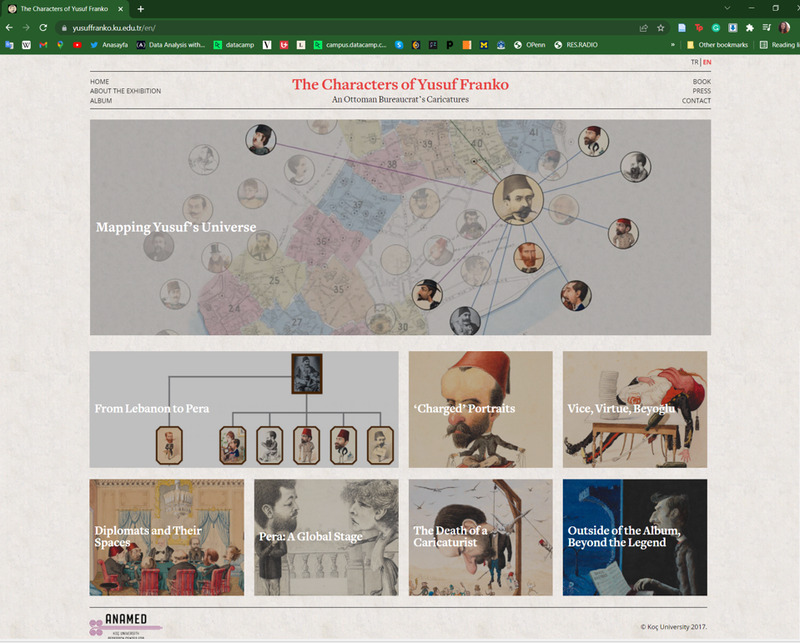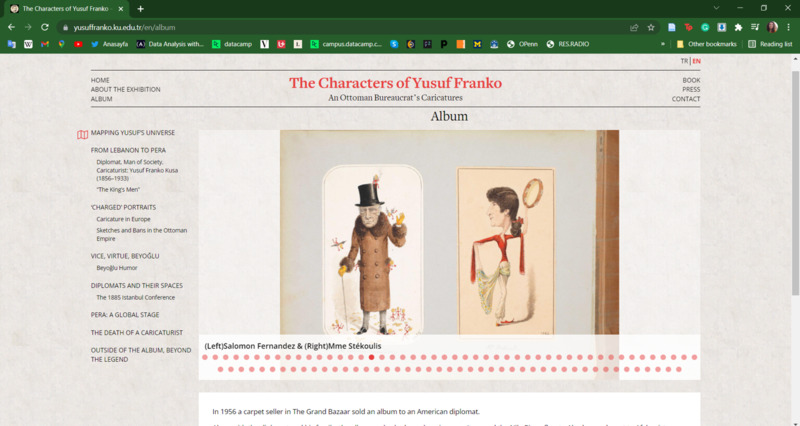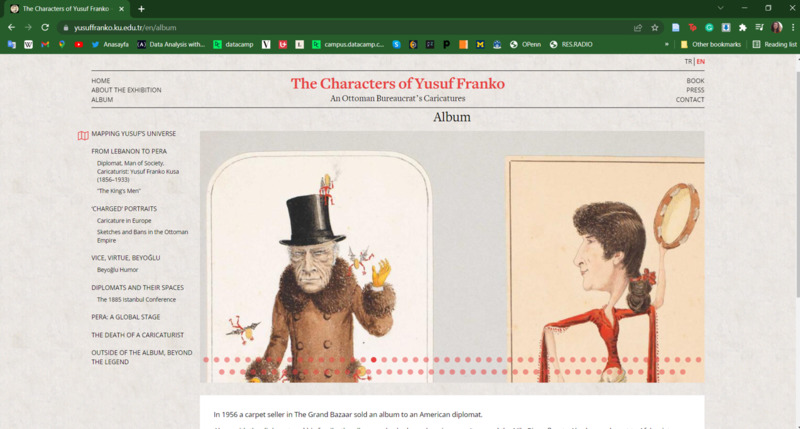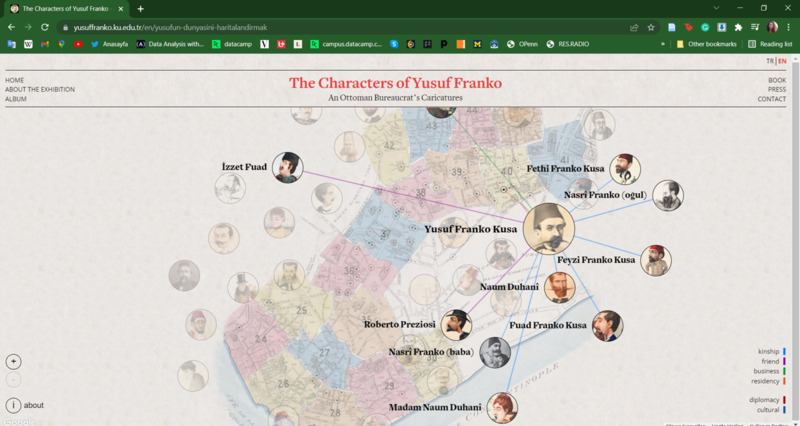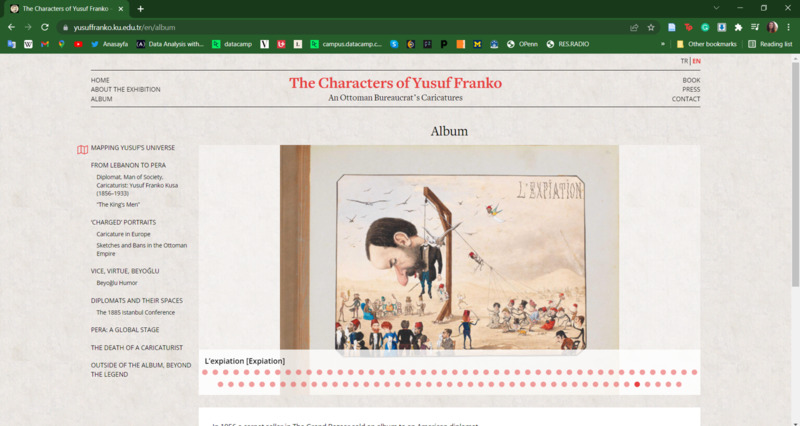The Characters of Yusuf Franko: An Ottoman Bureaucrat’s Caricatures web site review
Yusuf Franko or in his full name Yusuf Franko Kusa was born in İstanbul, during the second half of the nineteenth century. He was also an Ottoman bureaucrat working in the Ministry of Foreign Affairs. Moreover, he was an undiscovered caricaturist. The album contains his work did not surface for a very long time has been found and ANAMED (Koç University Research Center for Anatolian Civilizations) did an exhibition regarding Yusuf Franko and his characters. In this essay I will talk about the website created as a part of this exhibition which is called “The Characters of Yusuf Franko: An Ottoman Bureaucrat’s Caricatures” and exhibited between 26 January and 1 June 2017. [1]In order to provide a review, I will first describe the content and the form of the website. Afterwards I will in this order; explain the purpose of the website, talk about the design, functionality and build of the website, to evaluate the success of the website with regard to design, function, and historiography. Lastly, I will discuss whether and how components of this site, if any, should be taken and altered for the project which we focus: “Mapping Violence: War and Redevelopment in Sur, Turkey”.
The home page of the website [2] opens with eight thumbnails which are the sub-sections of the exhibition content; 1: MAPPING YUSUF’S UNIVERSE, 2: FROM LEBANON TO PERA: Diplomat, Man of Society, Caricaturist: Yusuf Franko Kusa (1856–1933)“The King’s Men”, 3:CHARGED’ PORTRAITS: Caricature in Europe Sketches and Bans in the Ottoman Empire, 4: VICE, VIRTUE, BEYOĞLU: Beyoğlu Humor, 5: DIPLOMATS AND THEIR SPACES: The 1885 Istanbul Conference, 6 : PERA: A GLOBAL STAGE, 7: THE DEATH OF A CARICATURIST, 8: OUTSIDE OF THE ALBUM, BEYOND THE LEGEND (Figure 1: Screenshot of the Characters of Yusuf Franko website home page). The first thumbnail titled “Mapping Yusuf’s Universe” took the viewer to the page which has most relevance to project we focus and has potential to provide ideas. Other seven thumbnails correspond to the different parts of the exhibition in each an explanatory text accompanies images of the various types of relevant documents from the hand-written letters to the photographs and printed journal pages. The top tier of the website divides to three sections; left and right section there are written thumbnails, in the middle the title of the website is visible and in the top right corner there is language option. (Figure 1)
The purpose of the website is to demonstrate world of the caricaturist and bureaucrat Yusuf Franko. To this aim each section explains a different dimension of the Yusuf Franko’s life. Moreover, there are sections regarding the story of the albums (and its circulation as an object) which are the center of the exhibition as well as the press around the exhibition. The website aims to give a complete overview of the world of Yusuf Franko. And the strongest tool they use is the mapping of the characters which has connections with Yusuf Franko.
One should discuss the design, functionality and build of the website while providing an evaluation of it. These three dimensions and their success is bifold. On the one side it has brought together the content of the exhibition in a very organized manner, the hierarchy of thumbnails in the home page is successful in terms of emphasizing the most interesting and may be the most relevant (both in terms of digital humanities scholarship and to our project of interest). On the other hand, it fails to highlight the main content which is the album consists of the Yusuf Franko’s caricatures. The Album itself is in the one of the pages, accessible via the written thumbnail: “ALBUM” in Figure 2 and Figure 3 one can observe the nature of the display of the album contents in the page. Also, the images of the album contents can be zoomed if one moves the cursor on the image.
At this point I would like to zoom in and focus on the “Mapping Yusuf’s Universe” page of the website and discuss it through the same bifold evaluation. At first look this is definitely a success. As seen in Figure 4, the page consists of map in which Beyoğlu-Galata axis is covered (base map is the Goad Plan [3]), points represent places in three categories, first unknown, second diplomacy and third cultural. These points connect with the people correlated. There are also caricatures of the people drawn by Yusuf Franko. If one moves the cursor around those caricatures the network of the given person is displayed in the four categories according to the legend: kinship, friends, business, and residency. The network displays the connection of the character with the other people as well as places.
Until this point the first side seems very successful. However, if ones open the last drawing of the album (Figure 5), the nature of the relationship among the characters of Yusuf Franko with him is shocking. It is the last caricature of the album and titled as : Expiation. In the image Yusuf Franko draw himself as a man who is hanged by these characters while two other group of characters are visible; one entertaining and other discussing an issue, each group ignores the dramatic event. This is the only source gives us somewhat an idea about what Yusuf Franko thinks of these people or an idea about the real universe of the author. This unique and significant piece is put as one of the many drawings of the album without any highlight. As I have evaluated in the previous paragraph the album which is the main content is already not central and this is only one of the many pages within the album. Providing that, in the home page in the bottom one of the thumbnails refer to this image only and include a very short text also explains what happened next: “We do not know if he really got into trouble because of his caricatures. What we know, however, is that none of Yusuf's caricatures has emerged other than this album.”[4]. This is a nice introduction to the material while the emphasis is limited. The map could have referred to this image as another layer of relationship web.
This brings us to the last section of this review; lessons for our project: “Mapping Violence: War and Redevelopment in Sur, Turkey”. The most important part is to think relationship between the original material and the map itself. While locating the subjects is extremely important; one should still care to form a strong bond with the material and the space. In a similar way we should be careful to display the interviews as much as the locating the timeline on the map and focus on the events narrated by the people experienced violence in Sur. The second lesson is about forming the hierarchy of the pages which can be both a powerful tool and an ignorant one neglecting critical information. The hierarchy within a page is equally important, while it is a strong design instrument one should use it wisely. Still the base map and the categorization of places is illustrated well. Graphically we can consider a similar visual language, also network display is done wonderfully; I assume that it is done with the Graph Commons. Still for our case we should add the change of the space as well, which is not the case for this project.
To conclude, The Characters of Yusuf Franko: An Ottoman Bureaucrat’s Caricatures web site is a good example for both inspiration and for avoiding pitfalls. The design decisions and their impacts are legible which overall means a success. Also, as an end note I would like to add that the topic and the project was extremely interesting, and I have fun while working on the website review. Also this is not the only source, a book which also has a page in the website can provide further information on the issue if one is interested. [5]
[1] Information regarding the exhibition ca be found in https://anamed.ku.edu.tr/en/events/the-characters-of-yusuf-franko-an-ottoman-bureaucrats-caricatures/
[2] The Characters of Yusuf Franko: An Ottoman Bureaucrat’s Caricatures web site is accessible from the following url: https://yusuffranko.ku.edu.tr/
[3] Chas E. Goad, Plan d’Assurance de Constantinople Vol II: Péra & Galata. London, 1905. IFEA. Digitization: SALT Research.
[4] THE DEATH OF A CARICATURIST: https://yusuffranko.ku.edu.tr/en/karikaturistin-olumu, author of the page also commented on the visual itself: Yusuf placed this work, titled “Expiation,” at the end of his album. Some of the characters he previously portrayed in the album are now pulling his rope. His family members are crying nearby, while beyond the diplomats are observing the situation impartially. This was part of the ‘caricature game’ that Yusuf played; at the same time, however, it was its end. We do not know if he really got into trouble because of his caricatures. What we know, however, is that none of Yusuf's caricatures has emerged other than this album.
Yusuf had killed the caricaturist, closed the album, and ended the game.
